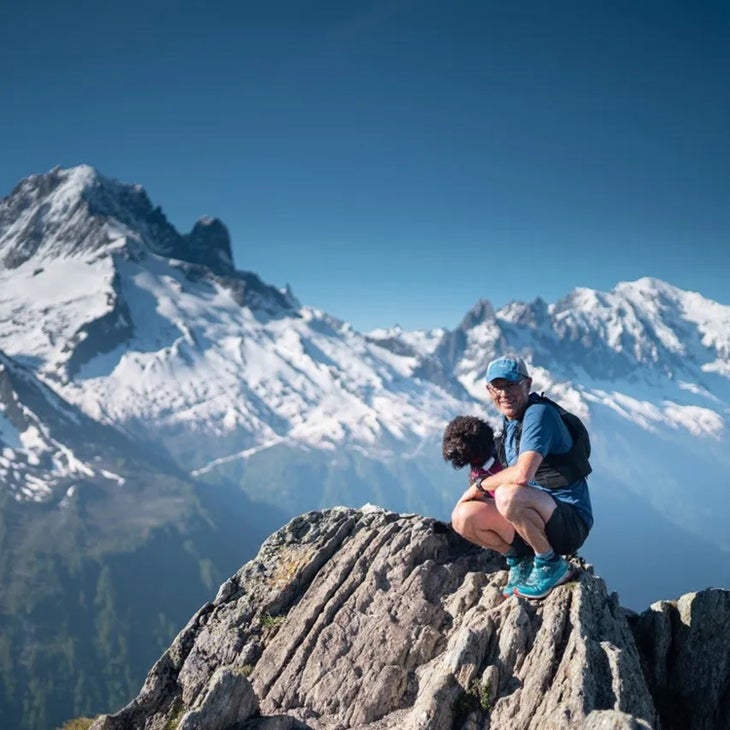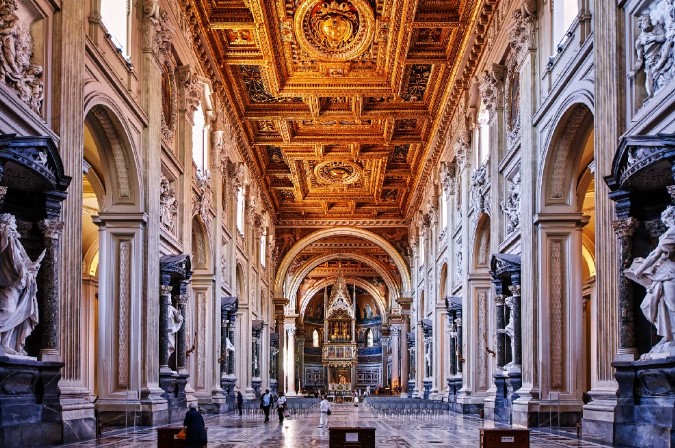This trek has it all: three countries, endless views of Western Europe’s highest peak—15,771-foot Mont Blanc—fresh-baked treats at high huts you stay in along the way, and views of climbers clinging to improbable spires. While downright decadent at times thanks to the gourmet food and drink en route, the Tour du Mont-Blanc, 103 miles of hiking that circles Mont Blanc and passes through France, Italy, and Switzerland, is no pushover. It comprises more than 32,000 feet of uphill hiking and descending. It offers gorgeous stretches of warm, summer Alps weather, yet full-on big-mountain storms can still descend on trekkers.
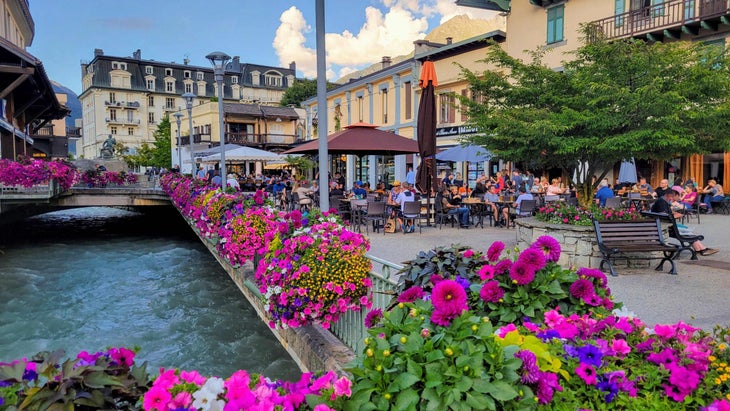
The Mont Blanc region of the Alps is huge, encompassing 155 square miles, with 60 square miles of glaciers and eleven summits over 13,000 feet. Ten thousand years ago, nomadic tribes gathered here, living off deer and chamois on the land and fish from the rivers. In time, they began herding animals, moving them to higher pastures in the summer, creating the annual Alpine rhythm called transhumance that persists to this day. Those paths created an intertwined network of trails around the massif. In the last 60 years, local communities worked on the ancient routes, upgrading them for modern use by active travelers. In the 1960s, old huts were updated, inns sprang up in the valleys, and the TMB took on its present form.
Starting and finishing in the adventure-crazed alpine town of Chamonix, France, at the base of Mont Blanc, the TMB is perhaps the world’s most famous pedestrian loop and definitely one of its most entertaining, passing through three countries and the resulting variety of cultures. Along with the lively hut scene, Michelin-star dining options en route, and stop-dead-in-your-tracks views, you may also see the world’s best trail runners breezing past.
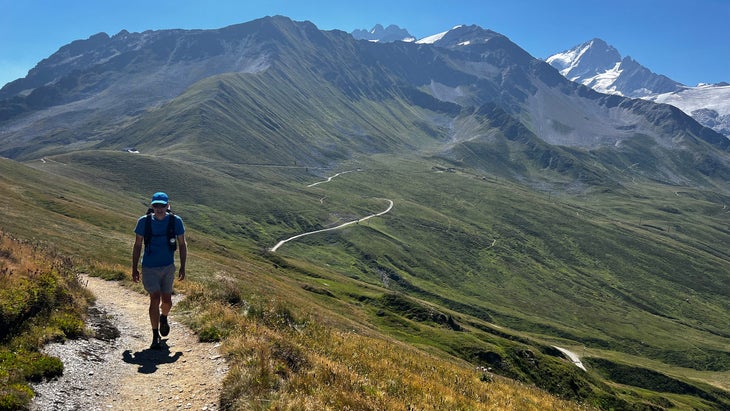
I began hiking and trail running the Tour du Mont-Blanc 15 years ago in sections—a day here, two days there. It wasn’t until seven years ago that I did the full loop in one continuous push. It was September 1, 2017, and 2,200 fellow trail runners joined me in the 14th edition of the iconic Ultra-Trail du Mont-Blanc, or UTMB. Held each year at the end of August and easily the world’s most famous trail race, UTMB is one part of the reason the TMB (walking version) has become so popular.
I’ve lived in Chamonix full-time for five years, spending five summers here before that, and founded and am part-owner of the trail-running tour company Run the Alps. The UTMB race is intense. Far more typical is the leisurely eight-day TMB hike I took with my two brothers and a cousin last September. My relatives booked a total of 11 days for the trip, which included their arrival and departure days, a day in Chamonix to adjust to Central European Time, and a rest day in Courmayeur.
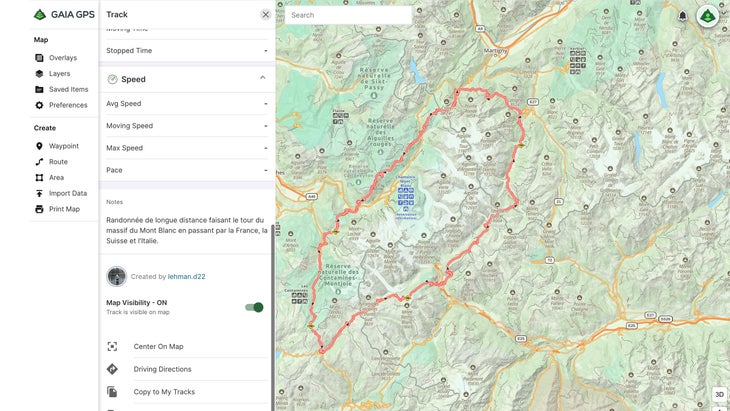
We meandered around the range, napping in alpine meadows, chatting with shepherds, and snarfing up lunches at huts and inns all along the way. We started around 8:30 each morning, right after the continental breakfasts, and dropped our bags with the hotel for the pre-arranged transport to the next destination. (Pro tip: Skipping the baggage transfer to save money is a dubious trade-off. You do not want to lug the extra weight over the high passes.) With an organized start time, we’d arrive at our next destination mid-afternoon, usually in time for a shower, a post-hike beer, and a nap before dinner. Our weather was perfect: blue skies, temperatures in the 60s, and a light breeze, day after day.
I’ve hiked or run the TMB a dozen times now, and here’s my advice for beginners on how to do it right.
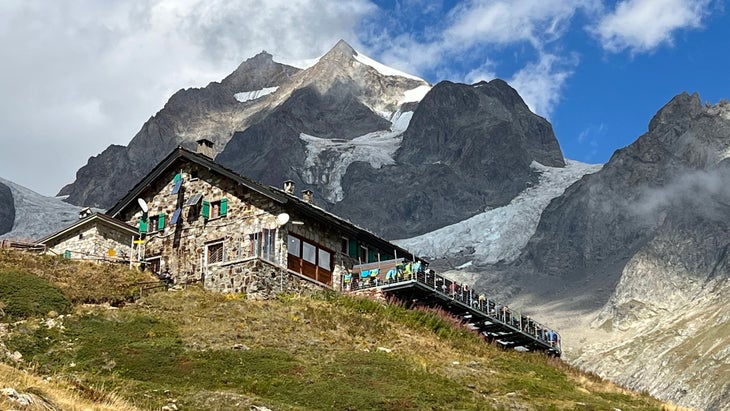
Table of Contents:
1) How to Get to the TMB
2) How Hard Is It to Hike the TMB?
3) How Long Does It Take to Hike the TMB?
4) The Best Time of Year to Hike the TMB
5) How to Book Your TMB Trip
6) Is the Trail Easy to Follow?
7) Lodging Options Along the TMB
8) Should I Plan My Own Trip (DIY), Self-Guide, or Go With a Guide?
9) Do I Have to Hike the Whole TMB Trail?
10) What to Pack to Hike the TMB
11) TMB Etiquette
12) The Best Piece of Advice of All
13) Resources
1) How to Get to the TMB
Nearly all TMB travelers fly in and out of Geneva, Switzerland, which is just about 90 minutes from Chamonix, the traditional start and end point of the loop. There are multiple shared shuttle services, which typically cost about €35 and should be scheduled in advance. At Run the Alps, we use Mountain Dropoffs. They’re reliable, they track your flight, and their drivers are well trained and always courteous.
2) How Hard Is It to Hike the TMB?
Most fit hikers will find the TMB to be within their abilities, especially if they opt for a luggage transport service between huts and hotels, leaving them to hike with light daypacks. But the trail is a big undertaking and can be challenging.
The longest day is usually about 20 miles, with roughly 4,500 feet of climbing and descending. Most days total around 15 miles, with between 4,000 and 5,000 feet of climbing. The highest point you’ll reach is 8,323 feet, and you work naturally up to it, so altitude is generally a non-issue, though concern about it is a common misconception about the TMB.
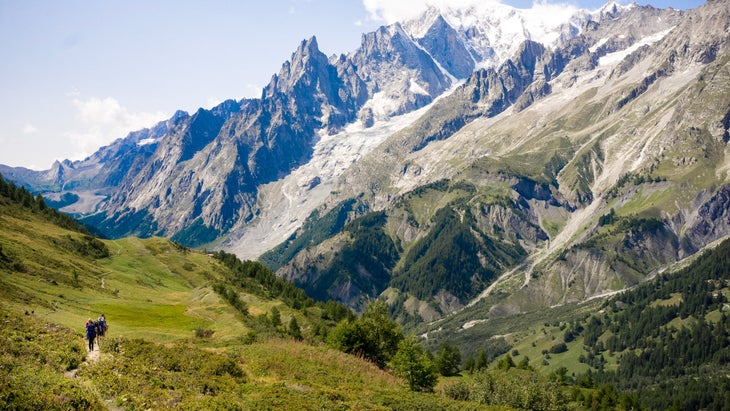
A lot of hikers and trail runners will find the TMB to have a good bit of “vert” (vertical gain) along the route. There are almost no truly flat sections, and depending on how you plan your route, you can do up to or even more than 33,000 feet of climbing during the trip. To train beforehand, find a nearby hill, get the pack you intend to use, load it up, and head uphill. If your local terrain doesn’t lend itself to TMB training, sign up for a few months at a gym with treadmills that go up to a 20 percent incline, and start hiking, doing your best to ignore the looks of gym rats when they see your pack on your back.
Old-school hiking boots are fine but, increasingly, TMB hikers are switching to sturdy trail-running shoes, from brands like Hoka, Salomon, or Merrell. No matter what you bring, wear them in well in advance—which means a few weeks of daily use, then at least a half dozen hikes, to make sure they are broken in and fit comfortably.
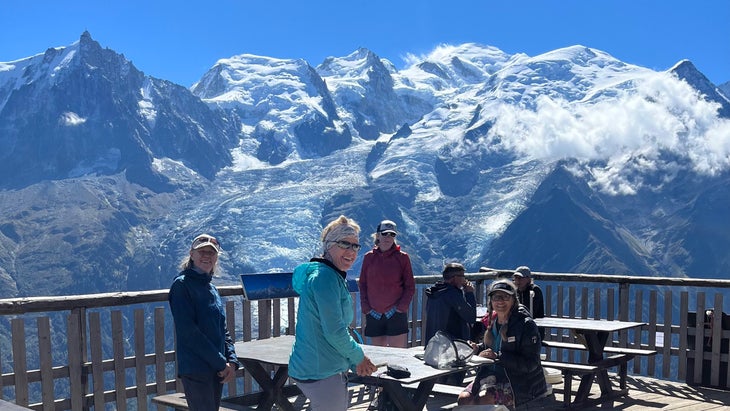
3) How Long Does It Take to Hike the TMB?
Depending on your jet-lag coping skills and your interest in rest days, plan on anywhere from a week to 12 days. The TMB breaks down nicely into village-based stops, and the most common itinerary looks something like this: Chamonix, France (add a rest day in for the day after you arrive); Les Contamines, France; Les Chapieux, France; Courmayeur, Italy (add a rest day in here); La Fouly, Switzerland; Champex-Lac, Switzerland; Trient, Switzerland; back to Chamonix (add in a rest day or two here before flying out). Bingo, that’s the loop.
4) The Best Time of Year to Hike the TMB
Be forewarned: midsummer is busy. The trail is getting popular. Even before COVID, there was a notable uptick in TMB usage, and last summer saw by far the biggest visitor numbers yet. An estimated 200,000 hikers, mountain bikers, and trail runners travel some sections of the TMB each year.
As of now, no permit is required to hike it, but you do have to book huts and hotels. The regional government has been talking with several nature reserves through which the TMB passes about implementing a permit system. Initially, at least, these permits would be both free and unlimited. The goal is to use the registration process to educate guests and track user numbers better—and hopefully to mitigate crowds.
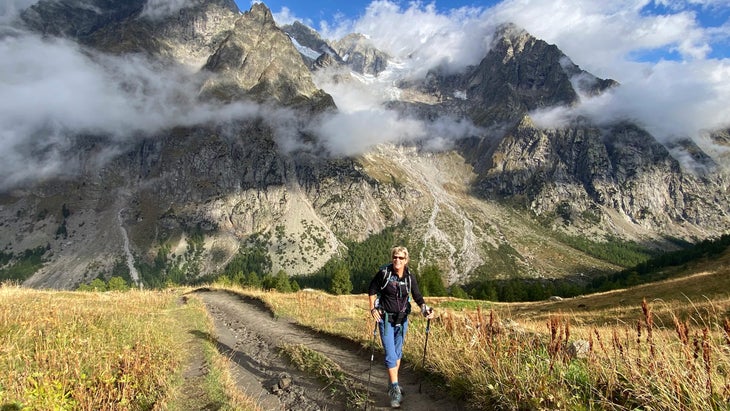
As a result of the surge in use, the gens du pays—the local people who live and work along the TMB—are scrambling 24/7 during July and August. If you must go then, you’ll need to plan well in advance to secure bookings and will pay top dollar. Many tour operators stop taking midsummer reservations for the TMB by mid-winter.
If you have a flexible schedule, I’d suggest booking during the second half of June, or after the UTMB race at the end of August, when things quiet down again.
In the shoulder seasons of June and September, bookings will be easier and refuge staff will have more time to visit with guests and perhaps even share a beer. On the front end of the shoulder season, the last two weeks of June, high passes might still be holding onto their snowfields, and you’ll need to use caution if the slopes are frozen solid. Bring hiking poles with carbide tips and microspikes for traction, and always check conditions locally with tourist offices before striking off.
The September shoulder season is arguably better, thanks to snow-free passes and good odds of blue skies. Most refuges and public transportation are open and running until about mid-September. This late season on the TMB is a wonderful time, with fewer crowds and a bit more wildness. Warmer gear is a must, though, as nighttime temperatures drop to the 50s and lower, and be aware that snowstorms might shut down travel for a day.
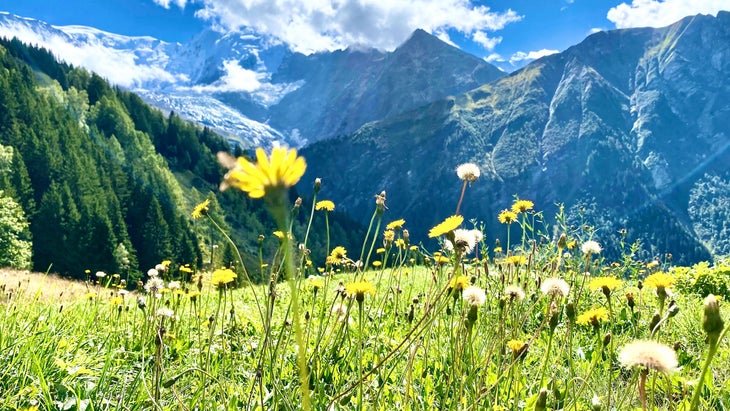
July and August are the high season. If that’s your vacation window, booking a year ahead will help you get the hotel you want. (Pro tip: Ask your hotel to pack a bag lunch for you the night before, so you can enjoy lunch from a quiet pasture, rather than waiting to place an order with overworked hut staff.) Huts usually don’t allow picnicking at their facilities, but if you pass by before or after the lunch rush, you can always enjoy a cafe au lait with the view.
Even if it’s busy, it’s still the TMB. If you don’t mind sharing vistas with fellow travelers, the fundamentals are pretty darned spectacular. You’ll need a thesaurus when texting home, because hackneyed travel adjectives like spectacular, stunning, amazing, and jaw-dropping will all sneak into your writing. For once, they won’t be overstatements.
5) How to Book Your TMB Trip
You can set up the whole circumnavigation yourself, go with a guide, or use a tour operator to book everything in advance for you. Whatever you choose, set things up as far ahead as possible. “You need to be planning 10 months in advance to secure space if you want to get into all the hard-to-book places,” says Troy Haines, owner of Alpinehikers, a guided and self-guided hiking tour operator that has been leading trips on the TMB for two decades.
There is good news, though, for those with an open approach. “Being flexible in your thinking really helps,” says Haines. “If you have a range of dates that work, or are happy with a dorm one night or a fourth-choice hotel, or even taking a taxi to a nearby village, then there is almost always something we can do to put together a trip.”
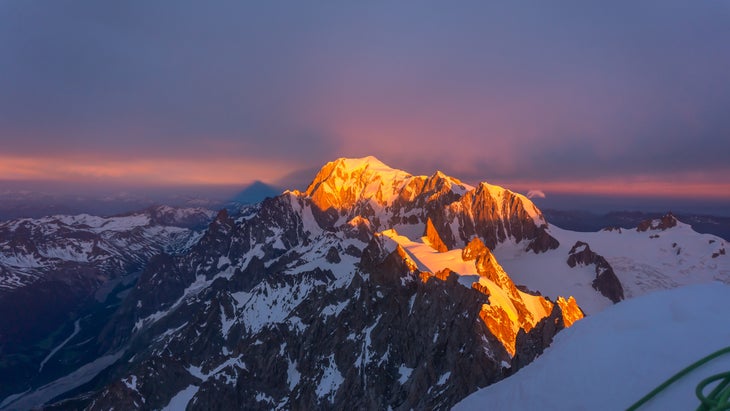
If you’re planning your own TMB hike and working on the logistics in late winter or spring for the coming summer, you may need to get creative in at least one overnight destination and possibly several. Look for hotels and inns in adjacent villages, and schedule Taxi Besson, a service that gives hikers rides to and from trails, to meet you at a specific location and time and return you to the trek the following morning. Places that traditionally get booked out along the trail include: Les Chapieux, France, and La Fouly and Trient, Switzerland. Instead, taxis can take you to the Savoie town of Bourg St. Maurice or quiet, atmospheric villages like Beaufort or Arêches. If La Fouly is full, take the Swiss Post bus to Orsieres and then Champex-Lac, skipping ahead a day. If Trient is full, look to Finhaut, Switzerland, or Vallorcine, France. Consider the switch-ups an adventure, and a chance to explore villages a bit farther afield.
6) Is the TMB Trail Easy to Follow?
Whenever you go, the TMB is one of the easiest trails in the world to follow. No matter whether you’re hiking in France, Italy, or Switzerland, the signage is clear, with distances marked. (Predictably, Switzerland wins for best and most accurate signs.) Many junctions are named, with elevations shown on the signposts. The TMB trail itself is well-worn, so even if visibility is poor, you should have no problem staying en route.
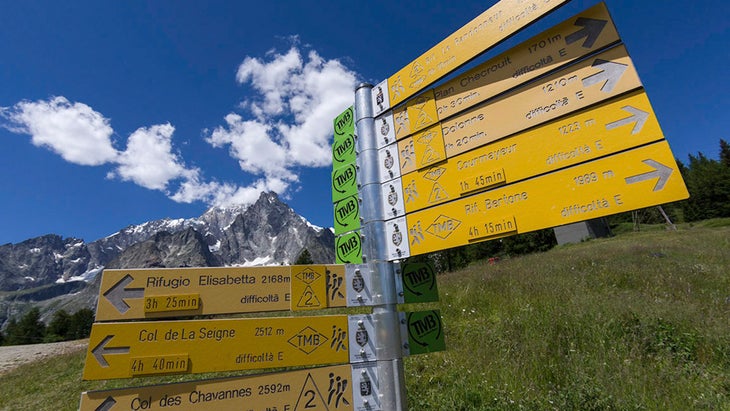
7) Lodging Options Along the TMB
There may be no multi-day trek in the world that offers such an array of overnight options. Some guests are rolling out sleeping-bag liners in shared dorm space, while others are sipping pricey Burgundy wines amid the five-star, red-carpet treatment at high-end hotels in Chamonix, Courmayeur, and Champex-Lac. (See the Resources section below for my favorite hotel options along the route.)
For those looking for a sky filled with thousands of stars, camping is an option, but with the recent proliferation of tents popping up around the range, it’s increasingly frowned upon by many of the guides on the trail and staff at nearby huts. If you want to camp, follow good Leave No Trace practices, and be as unobtrusive as possible. Regulations vary widely along the TMB. Camping is usually permitted outside of nature refuges after sunset and before sunrise. If you’re overnighting near a hut, drop in during the afternoon and ask permission of the hut caretaker or guardian. Commercial camping businesses exist in all of the key towns around the TMB. Because of the convenient alpine villages sprinkled around the route, however, the TMB is a great choice for anyone who wants to leave the tent and camp stove at home.
Because the TMB passes through three countries, camping regulations along the trail vary. Below is a quick overview of regulations.
In France, camping is allowed under the following conditions:
-In the proximity of a refuge, with the permission of the guardian.
-Outside of the Contamines nature reserve, you can pitch a tent between sunset and sunrise (7 P.M. – 9 A.M.). In the Contamines nature reserve, you must pitch your tent in the designated area near the Refuge de la Balme.
In Italy:
-Camping is not allowed under 2500m of altitude.
-In the Val Veny and Val Ferret zones, camping is only allowed in a designated campsite.
In Switzerland:
-Camping is allowed above tree level, but not within nature reserves.
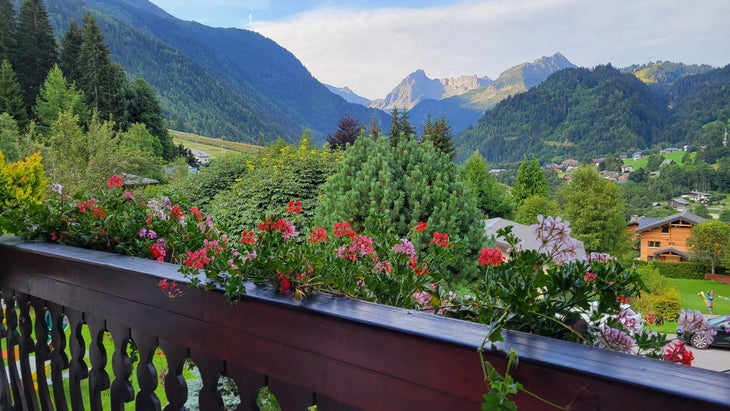
8) Should I Plan My Own Trip (DIY), Self-Guide, or Go With a Guide?
A) DIY
If you’re a planner, the TMB is made for you. You’ll get to cruise around on hotel websites in three countries, poring over photos of standard, superior, and deluxe rooms.
Stephanie Lefferts, the tour manager at my company Run the Alps, who works with more than fifty hotels, has three tips for DIYers:
-Book directly through a hotel’s website, if possible. You’ll often get a better rate and terms, and more money goes to the hotels, which are often family-run.
-When in doubt, go for the half-board option, which includes dinner. As Lefferts points out, “It’s really nice to walk downstairs for dinner after a long day on the trail and not have to wander the town searching for somewhere to eat.”
-You guessed it: “Book early!”
Over the years, a number of planning sites have emerged for the DIYer–see our suggestions below and grab a copy of the venerable TMB bible, Trekking the Tour du Mont Blanc by Kev Reynolds. The most recent edition was released in 2020. Be sure to get the IGN Tour du Mont-Blanc map as well.
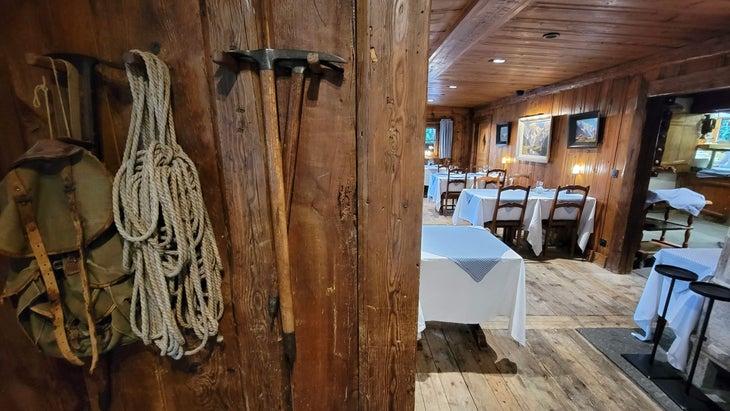
B) Find an Outfitter Who Sets Up Self-Guided Trips
This means that a company will book everything for you in advance so that all you have to do is show up and hike. Most TMB outfitters know the better inns and hotels along the route. And if you need to spend a night off the trail, they’ll schedule taxi transport for you. You’ll also get route descriptions for each day along with supporting materials that can save hassle and confusion. Most companies will also arrange for transport to and from the airport and baggage transfer during your hiking days, too.
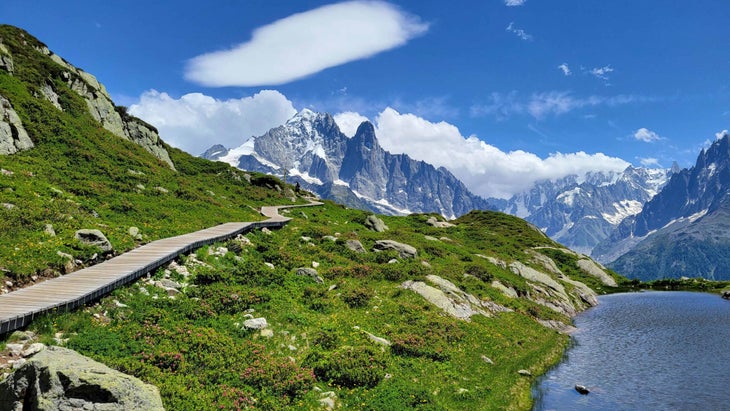
C) Go With a Guide
In the Alps, so-called “middle mountain” guides (meaning hiking rather than climbing guides) are a common sight, leading hikers and trail runners along paths throughout the region. In English, the designation is called IML, for International Mountain Leader. In French, it’s accompagnateur for a male guide and accompagnatrice for a woman. Guides in the Alps go through a rigorous training and testing process, and their knowledge runs deep on topics from mountain safety to flora and fauna to local customs and more. The additional cost of going on a guided trip can be well worth it, particularly if you’re busy and would like to just show up and follow a competent and friendly leader.
If you’re going on a guided trip, be sure to confirm that your company uses only licensed guides. Mountain police, Europe’s equivalent of a forest ranger toting a police badge, often check a guide’s paperwork, and more than one hapless group has had its TMB trip stalled by the presence of non-licensed guides.
If you use a commercial company for either a guided or self-guided tour, remember that not all companies offer the same tier of service. The cost difference can be thousands of dollars, and your overnight accommodations might range from a stuffy dorm room to a 600-thread-count king-sized bed with a mountain-view terrace. Read the fine print carefully to see what costs are covered, and if items like airport shuttles and in-country transport are foisted back your way.
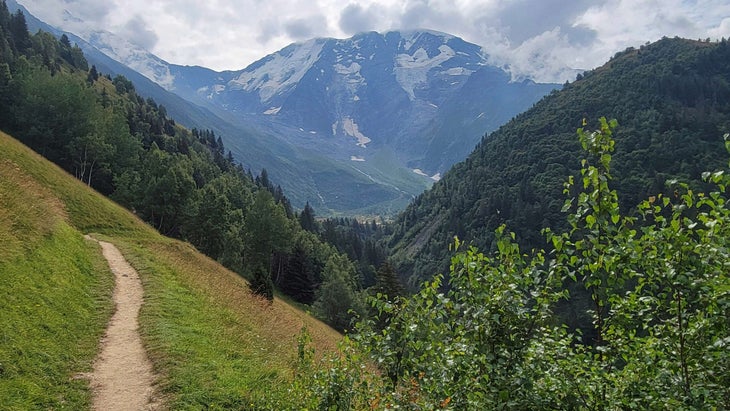
9) Do I Have to Hike the Whole TMB?
The TMB is well set up for hikers with limited time. Transportation around the region is relatively straightforward. There are multiple buses each day between Chamonix and Courmayeur through the Mont Blanc tunnel, and France’s SNCF passenger trains coordinate with Switzerland’s SBB rail system, which in turn dovetails with the country’s Postbus system. All of which means, getting around is easy. If you’re short on time, try some day hikes. These are my places to stay for dramatic day hikes around the region: Chamonix, Courmayeur, and Champex.
10) What to Pack For Your TMB Hike
Most summer days on the TMB are luxurious, with zephyrs rustling the pastures, blue skies, and great hiking temperatures. But any given day can be downright brutal. Hope for the best, but be ready for the worst. Here’s a typical packing list:
-Warm and waterproof clothing for cold days, including a waterproof jacket and pants, a thermal top, and hat and gloves.
-Dry bags or a waterproof cover for your pack.
-Hiking boots or sturdy trail running shoes. Go for at least a few long hikes beforehand to make sure they are a good fit.
-Hiking or trail-running poles are a common sight on the TMB, and for good reason. The slight shifting of weight from legs to arms will reduce fatigue later in the day, and the third point of contact will make steep terrain safer.
-Sunglasses and sunscreen.
-A large water bottle or hydration pack that can hold at least two liters.
-First-aid kit including a mix of bandages and blister aids.
-About 200 euros, even though many of the mountain stops and most mountain refuges accept cards.
-A cell phone with an international plan. It’s a good idea to store the emergency numbers in your contacts. In France and Italy, the number is 112. In Switzerland, it’s 114. Calls to emergency numbers are free. Rescue fees vary from free to pricey throughout the Alps. Here’s a good rundown on the details. (TLDR? Get a membership in the Swiss nonprofit REGA, make sure your health insurance is up-to-date, and buy travel insurance from a reputable company, like IMG.)
-Bring your ATM card–there are ATMs at every stop except Les Chapieux and Trient. Just call your bank first, to make sure the card is authorized for France, Italy, and Switzerland. Though Switzerland uses the Swiss Franc, euros are generally accepted around the loop.
-If you’re staying at mountain huts, most require a sleeping-bag liner, which you’ll use in combination with wool hut blankets that won’t see a good washing until the close of the season. You can buy cotton, which has more bulk, or silk, which costs more but stuffs into about the size of a rolled washcloth.
-While most huts provide Crocs or flip-flops for indoor use, it’s not a bad idea to bring your own that are actually comfortably sized to you, instead of whatever is in the hut shoe cubby.
-Ear plugs if you’re sharing overnight accommodations.
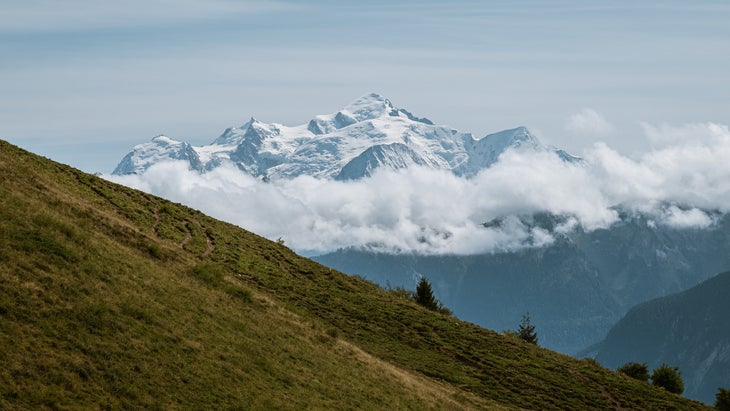
11) Learn the TMB Etiquette
As with many long-distance paths, there are rules to the road. On the TMB, they are well-established, thanks to the long history of the route.
At refuges:
-Shoes and poles in the boot room only.
-In shared rooms, try to be quiet at night, and don’t turn the light on if someone is sleeping. Turn cell phones off or to Airplane Mode.
-Use an indoor voice. (Yes, it really is true: Americans tend to be among the loudest.)
-A small tip is appreciated–perhaps a euro for a snack and cafe au lait, a few euros for a meal.
On the trail:
-Remember that there might be bikers, runners, or faster walkers who want to get past, so be ready to step aside.
-Share a “Bonjour” when passing fellow hikers.
-Please, don’t play music out loud. Grab the ear buds.
-Evidence is starting to mount that swimming in lakes has a negative impact on their ecosystems. Please minimize or avoid it, especially if you’re wearing sunscreen.
12) My Top TMB Advice: Treat Yourself!
The TMB has to be the hiking path with some of the tastiest aid stations en route. While you’ll burn over 4,000 calories a day, if you’re not adding it all back, well, you’re missing out.
This is ten years of in-depth culinary research in a handful of short paragraphs, but rest assured, the pleasure was all mine.
On one of my first TMBs, circling the Mont Blanc massif in four days as part of a trail-running mini-vacation, our group kept a literally running tally of the number of tartes aux myrtilles (blueberry tarts), pain au chocolates, and cafe au laits we had. We quickly lost track, though.

My brothers, cousin, and I repeated a version of this game last fall. In fact, counting tartes and other treats is a classic TMB tradition. Thanks to those baked mountain goodies and endless big views, the miles pass quickly. Before you know it you’ll be back on the steps of the centuries-old St. Michel Church in Chamonix, celebrating with beers from Big Mountain Brewery and looking forward to a fromage-filled celebratory dinner at La Caleche.
Here are some of my favorite stops en route.
-Refuge Plan de l’Aiguille: While not on the TMB, this high hut above Chamonix is well worth a visit. So, book a jet-lag recovery day in Chamonix, and head here for a TMB warm-up. Claude and his staff make what is widely considered the best tarts in the Chamonix valley, fresh each morning. The typical spread is wild blueberry, strawberry, lemon, and raspberry. (Take in the Midi tram, the world’s second-longest, on the same day.)
-Chalet Miage: Stop for lunch at this rustic mountain farm before the French village of Les Contamines and order anything on the menu. Really. It’s that simple.
-Alpage Ville de Glacier: If you’re not taking Col des Fours, look for this farm just outside the hamlet of Chapieux and stock up on local Beaufort and Sérac cheese directly from the farmer.
-Refugio Elizabetta: Time your wanderings to stop in for their traditional Italian lunches like hearty bowls of polenta, and all for a good price.
-Courmayeur, Italy: This TMB stopover town has a wide array of great restaurants, so schedule a rest day here. Get a gelato or an ice cream at the Gelateria in the center of town, and sneak down a side alley for focaccia at Pan per Focaccia. Pro tip: ask your hotel to book a taxi to the QC Terme roman spas at Pré-Saint-Didier. If you end up wanting more, the same company has a new facility waiting to ease the end-of-trip aches and pains in Chamonix.
-Alpage de Bovine: Switzerland is all about comfort food, and the grated potato and cheese Rostï at this high Swiss farm stop will persuade you that all is well with the world. Save room for an apricot or blueberry tart.
-Refuge Col de Balme: Wrap your hands around a thick hot chocolate as you look down to Chamonix and eye the last ten miles of your loop around Mont Blanc.
Santé et à bientôt!
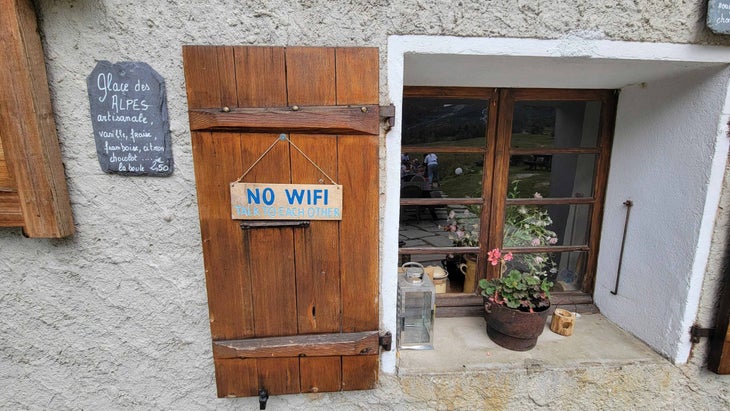
13) IMPORTANT RESOURCES FOR THE TMB
Helpful Sites for DIY Planners
Autour Mont Blanc is a one-stop online planning site, with links to key huts and other services along the way.
The Hiking Club offers paid support for DIYers who want a hand building their own trips.
Taxi Besson: Taxi Besson is the go-to company to shuttle your bags around the TMB. They work with most major hotels in the region. Drop your bag by in the morning after breakfast, and it will be waiting for you at your next hotel that evening. (In my outfit’s ten years of using them, they’ve never once failed us.) Pro tip: Follow the weight-limit guidelines, ask at the hotel desk exactly where to leave your bag, and don’t tie anything to the outside.
Mountain Drop Offs transfers between Geneva and the Chamonix valley.
Tour du Mont Blanc Facebook Group: With nearly 37,000 members, this Facebook group is lively, filled with useful information. Ignore the know-it-alls, and you’ll find tons of good intel.
If you’re going on your own, Emily Geldard, a longtime resident and the Run the Alps assistant manager, has created a handy summary of options to shorten many of the days, in the event of inclement weather or injury. “The Long and Short of the TMB” offers information on bail-out options, plus a list of ways to extend each day if yesterday’s pastries have you energized for bonus terrain.
Outfitter Recommendations for Guided and Self-Guided Hiking
Alpinehikers, Cloud Nine Adventure, Alpenwild, and Happy Tracks are highly regarded tour operators who offer both guided and self-guided trips on the TMB.
Outfitter Recommendations for Guided and Self-Guided Running
Run the Alps is an Alps-based company with U.S. roots. (The author is the founder and part owner.) Run the Wild and Tracks and Trails are two other good options.
If You Need a Doctor
If you have an emergency, use the emergency numbers or ask your accommodation host to call a local doctor. Les Contamines, Courmayeur, and Argentière have pharmacies.
Apps
A handful of apps make the TMB easier to navigate, including Gaia GPS, which also contains weather data. Meteo Swiss is often used for weather.
(Gaia is owned by Outside Inc., the company that owns Outside.)
Learn Some of the Local Language
French / Italian:
Hello = Bonjour / Ciao
Thank you = Merci / Grazie
Breakfast = Petit Dejeuner / Colazione
How much is it? = Ça coûte combien? / Quanto costa?
Do you speak English? = Est ce que vous parlez anglais? / Parla inglese?
Where are the toilets? = Où sont les toilettes? / Dove e’ il bagno?
This way? = Par ici? / Da questa parte?
It hurts here = Ça me fait mal ici / Sono ferito qui
Mountain hut = refuge de montagne / rifugio di montagna
I need help = J’ai besoin d’aide / Ho bisogno di aiuto
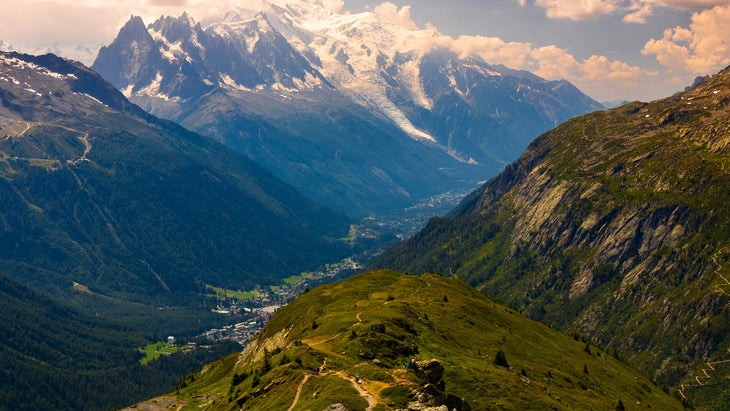
Great Side Trails to Explore
One of the best features of the TMB is that there are plenty of side trails to hike along the way. You can truly do your own hike, mixing the standard route with wilder variants, or hopping a local bus to skip sections. Hiking what we call a variant trail can be a great way to get away from crowds and find solitude. Here are a few of my favorites.
-France: Col de Fours: from Les Contamines to the must-see rustic lodge of Les Mottets, this is a direct variant that detours around Les Chapieux. It is a mere 350 feet of additional climbing–though much more technical than the norm–and a bit more than a mile shorter. It includes one of the highest points on the TMB (which should be avoided in bad weather). Best of all, there’s a high likelihood of seeing ibex.
-Italy: Val de Sapin: From Courmayeur to Bonatti Refugio, this adds an additional 1,300 feet of climbing and about a mile of distance. It is a wild and quiet valley, and you are likely to see ibex.
-Italy into Switzerland: Petit Col Ferret: Next to the Grand Col Ferret, this is an alternate route to La Fouly. It is the same distance and elevation, but the rocky descent is more technical. The trail is much quieter than the traditional route.
-Switzerland: Fenêtre d’Arpette: from Champex to Trient, this variant adds about 1,300 feet of elevation, and is a bit less distance, but it is a lot more technical and time-consuming. Because of the high altitude and slippery rock, it should be avoided in bad weather and certainly during the early season. The route’s steep and icy snowfields linger into early summer and have led to a fatal slide every few years. The scenery is wild and other-worldly, and the trail is usually quiet.
-Switzerland into France: Les Tseppes: From Trient to Argentière, France, this variant adds a few hundred feet of elevation and about a mile of distance. The start is steep and daunting, but worth the challenge. The trail is quiet, and you are treated to wide-ranging views of the Vallorcine valley and Mont Blanc.
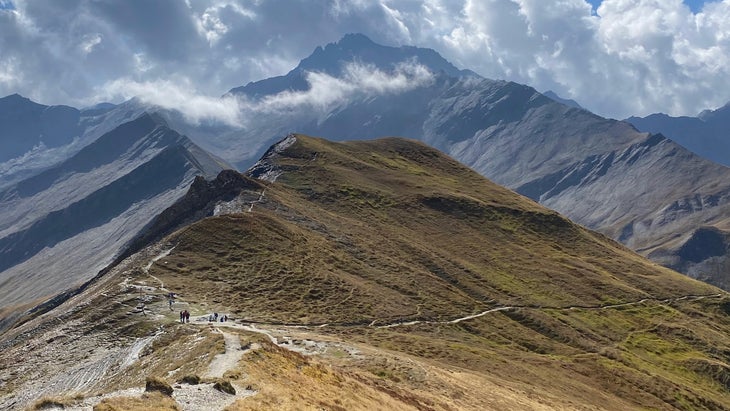
The Author’s Lodging Recommendations Along the TMB
Chamonix
-High End: If you want modern and plenty of amenities, Heliopic is your go-to. Want authentic French? Head to the Hameau Albert 1er.
-Middle: Le Refuge des Aiglons is modern, with a nice spa, pool, and outdoor seating. For something more rustic, head down the street to Hotel Oustalet, which features a large yard that’s somehow quiet, despite its central location.
-Rustic: La Boerne is located out of town in the tiny collection of chalets known as Tré-le-champ. It’s a ten-minute walk to the local train, which is 20 minutes from Chamonix. There’s also bus service from Argentière, a 15-minute walk away.
Les Contamines
-High End: Hôtel La Chemenaz. Spacious private rooms and suites, with an outdoor swimming pool and spa.
-Middle: Gai Soleil. Family-run by passionate staff, this converted farm has been hosting tourists since the 1920s. The private rooms have a cozy, alpine feel.
-Rustic: Chalet Refuge de Nant Borrants. Set on the TMB trail, a little outside of Les Contamines, this refuge is secluded and traditional. The dormitories are clean, with just six to nine people in each room.
Les Chapieux
-High End: Taxi to Bourg St-Maurice and stay at Hotel L’Autantic or Hotel Base Camp Lodge des Arcs.
-Middle: Chambres du Soleil. Family-run, with excellent food cooked by the husband. There are woodburners in the dining rooms, and blankets in the bedrooms made from local wool.
-Rustic: Refuge Les Mottets. The food is hearty mountain style using local cheeses, and the dining room is decorated with historic farming equipment. A refuge staffer often plays music at dinner time on the player piano in the dining room.
Courmayeur
-High End: Grand Hotel Courmayeur. Modern and stylish rooms, with an indoor pool and spa.
-Middle: Bouton D’Or. Traditional, alpine decor, and a fantastic breakfast buffet that is all homemade. The fruits in the breakfast tarts are grown in the kitchen garden.
-Rustic: Cabane du Combal. A secluded location in the mountains, on the TMB but outside of Courmayeur.
La Fouly:
-High End: Take a taxi to Verbier and stay at La Cordée des Alpes. Modern rooms with alpine decoration.
-Middle: L’Hôtel Edelweiss. Clean, modern rooms that have been recently renovated.
-Rustic: Gîte Alpage de La Peule. This is an active dairy where you can buy the products, and see how different cheeses are made.
Champex:
-High End: Hôtel Alpina. A husband-and-wife partnership with Michelin-standard food cooked by the husband. The building is small and has a private, family feel.
-Middle: Hôtel Splendide. A historic and grand hotel built in the 1930s. Think high ceilings, stained-glass windows, and creaky wooden floorboards.
-Rustic: Relais d’Arpette. A traditional mountain auberge on a variant taking you a 20-minute walk off the TMB, on the Fênetre d’Arpette, in a secluded valley outside of Champex. Fantastic views.
Trient
-High End: Take a taxi to Argentière and stay at the Hôtel Les Grands Montets. Access to a spa and indoor swimming pool. The rooms are cozy and comfortable with alpine deco.
-Middle: La Grande Ourse. Clean, modern rooms and friendly staff.
-Rustic: Refuge Le Peuty. Excellent food served in a yurt with homemade, artsy decorations.
Argentière
-High End: Hôtel Les Grands Montets. Access to a spa and indoor swimming pool. The rooms are cozy and comfortable with alpine deco.
-Middle: With an old standby, the Hôtel de la Couronne, newly sold and under renovation until at least December 2023, middle-of-the-road accommodations are thin in Argentiére. A good alternative is to take public transport or a train to Chamonix or Vallorine, and double up your nights in one of your last hotels.
-Rustic: La Boerne. Another traditional auberge that is right on the TMB trail. It is in a quiet, secluded spot with a beautiful terrace. The building is full of character, with wooden beams and bunkbeds.

If You Get Shut Out of the TMB This Year
Troy Haines of Alpinehikers likes to point clients toward other, quieter destinations in the Alps, such as the Haute Route between Chamonix, France, and Zermatt, Switzerland; Switzerland’s Bernese Oberland; or Italy’s Dolomites. “All of them, TMB included, are simply stunning,” Haines says. “You really can’t go wrong.”
How to Be a Conscientious Traveler
While the seven principles of Leave No Trace are not specifically called out along the TMB, they are excellent guidelines, particularly as the TMB or any other place becomes busier. Learning a few phrases of the local language is always a nice icebreaker and shows respect, and please be patient with busy hut and innkeepers. When passing through the huts, follow the simple protocol of removing and storing boots and poles. Protocols are often posted right inside the doors.
Doug Mayer is the founder of the trail-running tour company Run the Alps. He lives in Montroc, France, 100 yards from the TMB, where he often trail runs with his labradoodle, Izzy. His new book is The Race That Changed Running: The Inside Story of the UTMB.
